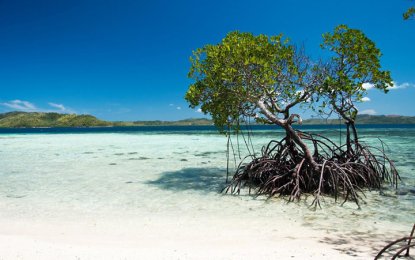
This photo of a mangrove tree extending to the sand's surface was taken by Francisco Fernandez Jr., president of the Calamianes Association of Tourism Establishments, Inc. (CATE) and General Manager of Darayonan Lodge & My Blue Backpack Tours. He took the photo to show how clean Coron waters are despite the high levels of coliform in the bay. (Photo courtesy of Francisco Fernandez Jr.)
PUERTO PRINCESA CITY, Palawan -- An association of tourism establishments in Coron denied Monday that the hazardous level of coliform detected in their waters has streamed into much-loved island destinations in the whole bay.
Calamianes Association of Tourism Establishments, Inc. (CATE) President Francisco Fernandez Jr. said on the group's official Facebook account on Monday (March 26) that the coliform-infested area is confined to the coastline of Coron town and is far from where tourists go to enjoy the sand and sea.
He said Kayangan Lake, for instance, is 4.6 kilometers off Coron Bay, where the high content of coliform had been continuously detected since 2011.
The likes of Luluyuan or Barracuda Lake is 4.8 kilometers; Lusong Gunboat Wreck is 19.6 kilometers; Malcapuya Island area (includes Banana Island, Bulog Uno, Bulog Dos) is 26.6 kilometers, and Siete Pecados Marine Park is three kilometers from Coron town or 0.5 kilometers from Maquinit Hotsprings, are also far from the shoreline of the main town.
“In the past week, there have been several reports in the media about high levels of coliform in Coron Bay. This is correct, but please note that the coliform infested area is confined to the coastline of the town,” he said.
Fernandez, whose family operates the Darayonan Lodge & My Blue Backpack Tours in Coron, added that tourists who wish to go to their town should take note that the distances are point-to-point or in a straight line.
“The actual route of the sea current is much farther since it has to go around the islands,” he said, noting that distances were measured using Google Earth.
Fernandez said that the government and the private sector “are one in finding a solution to the problem.”
“We, at Darayonan Lodge, fully support these efforts. The good news is, Coron Bay is a large body of water and practically all the major tourist spots are located quite a distance from the town's coastline,” he added.
Although the issue made headlines more than a week ago, Fernandez said the town “in general is still enjoying robust tourist arrivals.”
“The news has not affected any of our bookings so far. We are still enjoying good occupancy. We also have not had any cancellations yet due to statements released in media,” he added.
Meanwhile, a press statement released on March 23 by the office of Coron Mayor Ajerico Barracoso, said Coron remains safe for tourists.
“Notwithstanding DENR’s report on water examination conducted by the agency at Coron Bay, Coron’s tourism destinations remain safe for tourists to enjoy, primarily because all tourism destinations are located in scenic islands several miles away from the town proper,” it said.
It further stated that Barracoso is seeking the help of the national government in providing a centralized sewage treatment plant in the poblacion area, and a permanent relocation site for 4,500 Yolanda-displaced families.
Through the municipal government’s Solid Waste Management Office, coastal clean-up in Coron is intensified through the program “Alagaan Sariling Bayan.” (with reports by Keith Anthony Fabro/PNA)
